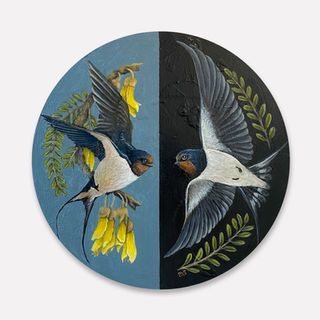Land,Sea Sky Current
This series gathers works inspired by the ever-shifting horizon of Papamoa. The dunes rise and fall like soft architecture, the ocean etches its rhythms into the sand, and the sky drapes the distant hills in shifting veils of colour. The exhibition explores the meeting ground where these elements overlap and blur, capturing the energy that makes this place unique — grounded in whenua, shaped by moana, and framed by the vast rangi above. Papamoa is a landscape of constant change, its moods set by weather and season, echoed by the growth of a community drawn here by its beauty.

Songs of the forest 2023
Recent works that celebrate the beauty of the precious native birds of New Zealand. Please contact me for more info or to arrange a viewing/purchase.

Taking Sides 2022
Commissions available via enquiry. Please contact me for more info.

Flock or Folly
Full exhibition catalogue
























































